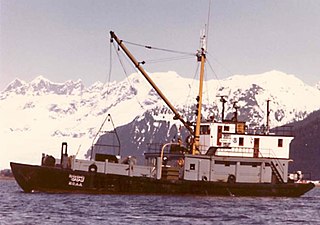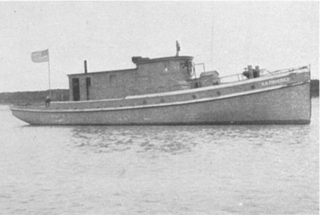
The United States Fish and Wildlife Service is an agency within the United States Department of the Interior dedicated to the management of fish, wildlife, and natural habitats. The mission of the agency is "working with others to conserve, protect, and enhance fish, wildlife, plants and their habitats for the continuing benefit of the American people."

The United States Fish Commission, formally known as the United States Commission of Fish and Fisheries, was an agency of the United States government created in 1871 to investigate, promote, and preserve the fisheries of the United States. In 1903, it was reorganized as the United States Bureau of Fisheries, sometimes referred to as the United States Fisheries Service, which operated until 1940. In 1940, the Bureau of Fisheries was abolished when its personnel and facilities became part of the newly created Fish and Wildlife Service, under the United States Department of the Interior.

NOAA Ship John N. Cobb was a National Oceanic and Atmospheric Administration research vessel in commission from 1970 to 2008. She was named for John Nathan Cobb and was the oldest commissioned ship in the NOAA fleet when she was decommissioned, having previously served in the United States Department of the Interior′s Fish and Wildlife Service from 1950 to 1956 and in the United States Fish and Wildlife Service′s Bureau of Commercial Fisheries from 1956 to 1970 as US FWS John N. Cobb.

USS Raeo (SP-588) was a United States Navy patrol vessel in commission from 1917 to 1919. Prior to her U.S. Navy service, she operated as the motor passenger vessel Raeo from 1908 to 1917. After the conclusion of her U.S. Navy career, she served as the fishery patrol vessel USFS Kittiwake in the United States Bureau of Fisheries fleet from 1919 to 1940 and as US FWS Kittiwake in the Fish and Wildlife Service fleet from 1940 to 1942 and from 1944 to at least 1945, and perhaps as late as 1948. During World War II, she again served in the U.S. Navy, this time as the yard patrol boat USS YP-199. She was the civilian fishing vessel Raeo from 1948 to 1957, then operated in various roles as Harbor Queen from 1957 to 1997. She became Entiat Princess in 1998 and as of 2009 was still in service.

The second USS Calypso (SP-632) was a United States Navy patrol vessel in commission from 1917 to 1919. She originally operated as the private motorboat Calypso from 1909 to 1917. After the conclusion of her U.S. Navy career, she served as the fishery patrol vessel in the United States Bureau of Fisheries fleet from 1919 to 1940 as USFS Merganser and in the Fish and Wildlife Service fleet as US FWS Merganser from 1940 to 1942.

NOAAS Oregon II is an American fisheries research vessel in commission in the National Oceanic and Atmospheric Administration (NOAA) fleet since 1977. Prior to her NOAA career, she was delivered to the United States Fish and Wildlife Service's Bureau of Commercial Fisheries in 1967 as US FWS Oregon II, but not commissioned. She was transferred to NOAA in 1970, but was not placed in commission until 1977.

NOAAS Townsend Cromwell was an American fisheries research vessel that was in commission in the National Oceanic and Atmospheric Administration (NOAA) fleet from 1975 to 2002. Prior to her NOAA career, she was in the United States Fish and Wildlife Service's Bureau of Commercial Fisheries fleet from 1963 to 1975 as US FWS Townsend Cromwell.

NOAAS David Starr Jordan (R444)) was an American fisheries research vessel in commission in the National Oceanic and Atmospheric Administration (NOAA) from 1970 to 2010. She previously was in the United States Fish and Wildlife Service's Bureau of Commercial Fisheries fleet from 1966 to 1970 as US FWS David Starr Jordan.

NOAAS George B. Kelez, previously NOAAS George B. Kelez, was an American research vessel in commission in the National Oceanic and Atmospheric Administration (NOAA) fleet from 1972 to 1980. Prior to her NOAA career, she operated under the United States Fish and Wildlife Service′s Bureau of Commercial Fisheries from 1962 to 1970 as US FWS George B. Kelez and the National Marine Fisheries Service from 1970 to 1972 as NOAAS George B. Kelez.

NOAAS Murre II, previously NOAAS Murre II, was an American research vessel in commission in the National Oceanic and Atmospheric Administration (NOAA) fleet from 1970 to 1989. Prior to her NOAA career, she operated under the United States Department of the Interior′s Fish and Wildlife Service from 1949 to 1956 and under the United States Fish and Wildlife Service′s Bureau of Commercial Fisheries from 1956 to 1970 as US FWS Murre II.

US FWS John R. Manning was an American fisheries research vessel in commission in the fleet of the United States Fish and Wildlife Service from 1950 to 1969. She explored the Pacific Ocean in search of commercially valuable populations of fish and shellfish. After the end of her Fish and Wildlife Service career, she operated as the commercial fishing vessel MV R. B. Hendrickson until she sank in 1979.

MV Brown Bear was an American research vessel in commission in the fleet of the United States Department of Agriculture′s Bureau of Biological Survey and Alaska Game Commission from 1934 to 1940 and in the fleet of the United States Department of the Interior′s Fish and Wildlife Service from 1940 to 1942 and from 1946 to 1951, under the control of the University of Washington from 1952 to 1965, and in commission in the fleet of the United States Fish and Wildlife Service from 1965 to 1970 and of the National Oceanic and Atmospheric Administration′s National Marine Fisheries Service (NMFS) from 1970 to 1972.

USFS Crane was an American fishery patrol vessel that operated in the waters of the Territory of Alaska. She was in commission in the United States Bureau of Fisheries (BOF) fleet from 1928 to 1940. She then served as US FWS Crane in the fleet of the Fish and Wildlife Service from 1940 to 1960. After a brief stint in the fleet of the Alaska Department of Fish and Game during 1960, she was sold into private service, at various times named Crane, Brapo, Fishing 5, Belle, and Patricia during the 1960s and 1970s and then again Crane since 1978. She remained in service as of 2020.

USFS Teal was an American fishery patrol vessel that operated in the waters of the Territory of Alaska. She was part of the fleet of the United States Bureau of Fisheries (BOF) fleet from 1928 to 1940. She then served as US FWS Teal in the fleet of the Fish and Wildlife Service from 1940 to 1960. After a stint in the fleet of the Alaska Department of Fish and Game from 1960 to 1966, she was sold into private service, and remained in operation as of 2016.

USFS Scoter was an American fishery patrol vessel that operated in the waters of the Territory of Alaska. She was part of the United States Bureau of Fisheries (BOF) fleet from 1922 to 1940. She then served as US FWS Scoter in the fleet of the Fish and Wildlife Service from 1940 to 1950. Before her United States Government service, she was the commercial purse seiner Clatsop. She returned to that name and to private ownership after the conclusion of her U.S. Government career.

USFS Brant was an American fishery patrol vessel that operated in the waters of the Territory of Alaska and off Washington, California, and Mexico. She was part of the United States Bureau of Fisheries (BOF) fleet from 1926 to 1940. She then served as US FWS Brant in the fleet of the Fish and Wildlife Service from 1940 to 1953. She then operated commercially until she sank in 1960.

USFS Pelican was an American fisheries science research ship and fishery patrol vessel that operated along the United States East Coast and the United States Gulf Coast and in the waters of the Territory of Alaska. She was part of the United States Bureau of Fisheries (BOF) fleet from 1930 to 1940. She then served as US FWS Pelican in the fleet of the Fish and Wildlife Service – which in 1956 became the United States Fish and Wildlife Service – from 1940 to 1958. She served as a fishery patrol vessel while on loan to the Washington Department of Fish and Wildlife from 1958 to 1970, then briefly returned to the Fish and Wildlife Service's successor agency, the National Marine Fisheries Service. Her United States Government service ended when she was sold into private hands in 1972, and she remained extant as of 2018.

US FWS Henry O'Malley was an American fisheries science research vessel in commission from 1949 to 1951 in the fleet of the United States Department of the Interior's Fish and Wildlife Service. She was the first U.S. fisheries science vessel to explore the central Pacific Ocean in search of commercially valuable populations of fish. Her career was cut short by a requirement for cost-prohibitive repairs.

US FWS Hugh M. Smith was an American fisheries science research vessel in commission from 1949 to 1959 in the fleet of the United States Department of the Interior's Fish and Wildlife Service. She was among the first U.S. fisheries science vessels to explore the central Pacific Ocean in search of commercially valuable populations of fish.

US FWS Charles H. Gilbert was an American fisheries science research vessel in commission from 1952 to 1970 in the fleet of the United States Department of the Interior's Fish and Wildlife Service and from 1970 to 1973 in the fleet of the National Oceanic Atmospheric Administration as NOAAS Charles H. Gilbert. She was among the first U.S. fisheries science vessels to explore the central Pacific Ocean in search of commercially valuable populations of fish.






















